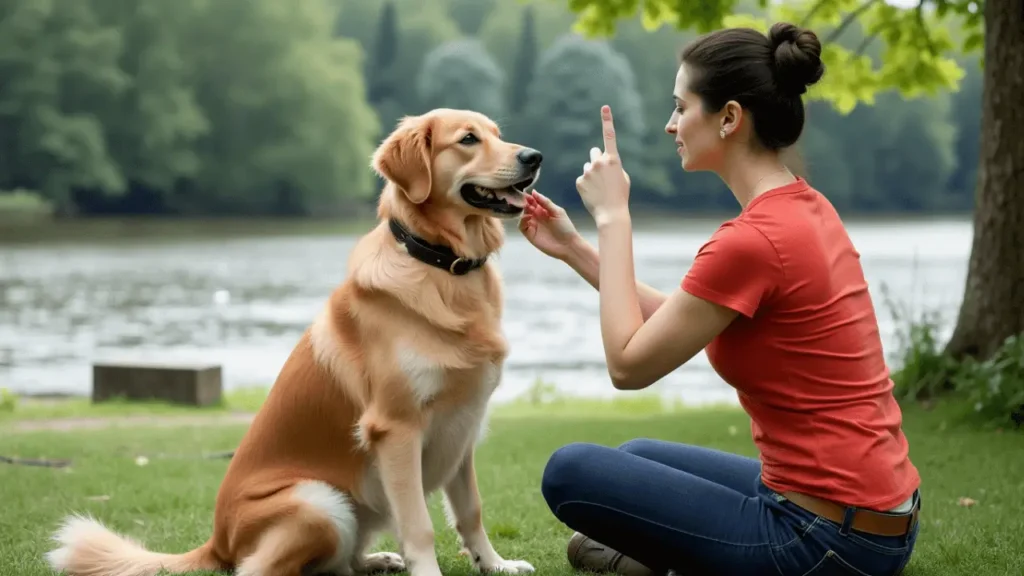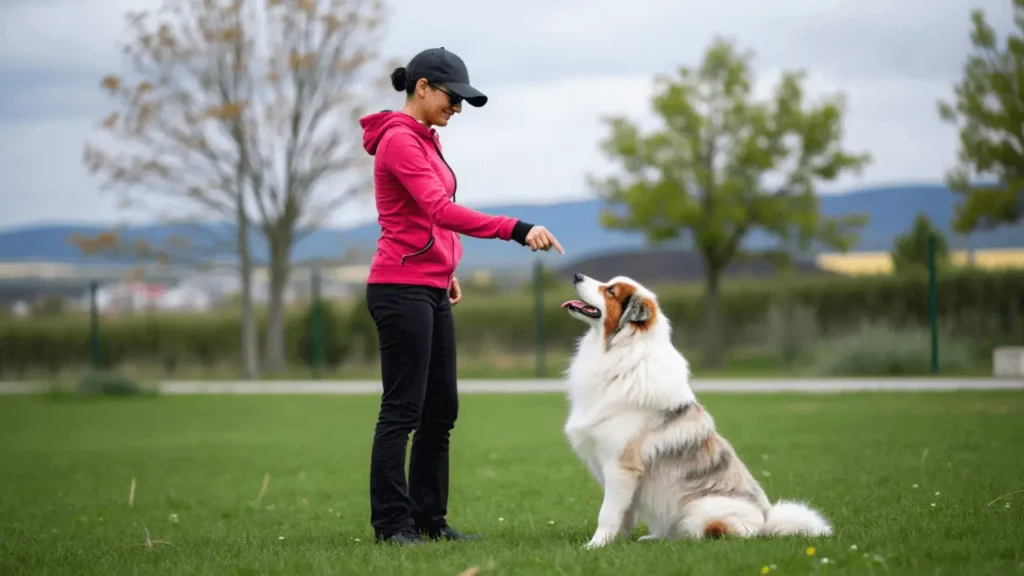Dog Training Near Me – Best Trainers Puppy Training
Ever thought about how good training can change your dog’s behavior and your bond? Now, finding dog training near you is easier than ever. Whether you’re new to dog ownership or want to improve your dog’s skills, it’s key to find the right training.
There are many programs out there, from puppy classes to service dog training. I’ve learned that training does more than just teach obedience. It also makes your dog’s life better. Let’s dive into why dog training is so important and how it can make both you and your dog happier.
Time needed: 2 minutes
- Dog Training Near Me – Best Trainers for Puppy Training
Searching for the best puppy training near you? This image showcases an experienced dog trainer helping a playful puppy learn obedience skills in a positive and supportive environment. The right trainer can make a huge difference in your pup’s behavior, ensuring they grow into a well-mannered and happy companion.

Why Dog Training Matters for a Well-Behaved Pet
Find the best training for your pup today! Discover top-rated dog training near you.
Dog training is key to a strong bond with my dog. It helps us communicate better and learn new skills together. National Train Your Dog Month in January shows how important it is.
How Proper Training Improves Dog Behavior and Obedience
Training my dog has many benefits. It stops bad behaviors and keeps my home clean. It also lowers my stress levels when my dog behaves well.
Going to dog training classes helps my dog meet new friends. This makes them more comfortable in new places.
Building a Strong Relationship with Your Canine
Training helps us understand each other better. Trust is crucial for learning and growing together. Positive reinforcement makes my dog feel safe and loved.
Trainers offer ongoing support. They know training can have ups and downs. But with their help, we can overcome any challenges.

Choosing the Best Dog Training Program for Your Pet
Knowing about different dog training programs helps me choose the best one for my dog. Each program meets specific needs, helping dogs of all ages and backgrounds. Whether my dog is a puppy or an adult, these programs help us bond better.
Essential Puppy Training Tips for a Well-Mannered Dog
Puppy training is key for a dog’s early development. These classes teach social skills and basic obedience. They use fun methods to keep learning fun.
Classes cover important commands like sit, stay, and come. This makes a strong start for my puppy. With programs like Dog Academy, my puppy learns to interact well with others.
Obedience Training for Dogs: Teaching Essential Commands
Obedience training is for dogs of any age. It teaches essential commands and improves our communication. Places like Bark Busters and Zoom Room offer customized training.
These courses focus on recall, leash manners, and basic commands. They help my dog behave better and learn good manners.
Addressing Aggression and Anxiety with Advanced Dog Training
Advanced training helps dogs with special needs like aggression or anxiety. It’s great for overcoming specific challenges. Programs like Fun Paw Care and iWorkDogs provide expert help.
Through advanced training, my dog learns to cope with issues. This ensures we live in harmony.

How to Locate the Best Local Dog Training Services
Finding the right dog training services is key for my dog’s growth. I start by looking at local options. Community boards, online listings, and friends’ tips are great for finding good trainers. Reading reviews and checking a trainer’s history in my area is also important.
Tips for Finding a Certified Dog Trainer in Your Area
Looking for trainers close to me narrows down my choices. I use social media, pet forums, and local directories to find them. Group classes help dogs socialize and learn obedience. In-home training is great for tackling specific issues in a familiar setting.
What to Look for in Professional Dog Training Services
Visiting training facilities and watching classes is a good way to assess services. It shows how trainers work with dogs and owners. I look for certified trainers who use humane methods.
It’s important to know what services are offered. Whether it’s group classes or one-on-one sessions, the trainer should meet my dog’s needs. This ensures the training is tailored and effective.
Choosing the Right Dog Trainer for Your Dog’s Needs
Finding a good dog trainer is key for pet owners. The dog training world is not well-regulated. So, it’s important to check a trainer’s qualifications and experience. Look for someone with a strong background and who uses positive training methods.
Trainers with certifications from groups like the Certification Council of Professional Dog Trainers are dedicated. They show they care about their work.
Why Certified Dog Trainers Lead to Better Results
When picking a dog trainer, think about their experience in training service dogs and fixing behavior problems. Ask about their education and any certifications they have. A good trainer knows the basics of training and understands behavior issues.
Some trainers learn by doing, while others have formal training. They should also teach your whole family how to train your dog. This way, everyone can help with training.
Finding a Dog Trainer for Service and Behavioral Needs
Ask if the trainer specializes in service dog training. Each dog is different, so a tailored approach is important. Trainers who know about behavior problems can help with issues like barking too much or pulling on the leash.
It’s a good idea to see if the trainer offers socialization and lets you watch training sessions. This way, you can see how they work and if it’s a good fit for you and your dog. Choosing a skilled trainer helps build a strong bond with your dog and leads to better training results.
Why Professional Dog Training Improves Long-Term Behavior
Professional dog training offers many benefits for dogs and their owners. It creates customized training plans that meet a dog’s specific needs. This approach makes training more effective and helps solve behavioral problems.
Tailored Dog Training Programs for Better Learning
Professional training means each dog gets a plan made just for them. This reduces behavioral issues, which can lead to dogs being rehomed. Dogs trained this way are 70% less likely to bark too much or chew things they shouldn’t.
Personalized training leads to a better connection between the dog and the trainer. This makes learning more successful for the dog.
Effective Dog Behavior Training to Fix Common Issues
Behavior modification is key for tackling serious issues like aggression or anxiety. Professional trainers use humane methods to address these problems. This improves the dog’s life and keeps the household safe.
Trained dogs are 80% more likely to listen in dangerous situations. This gives owners peace of mind. These techniques can greatly reduce bad behaviors, making life better for everyone.
Training also keeps dogs mentally active, cutting down on destructive behavior by 50%. Regular training strengthens the bond between dog and owner. 75% of owners see a big improvement in their relationship with their pet.
Choosing professional training boosts confidence in dog owners. It helps them handle their pet’s behavior better.
Puppy Training Essentials for Socialization and Good Behavior
Puppy training classes are key for a well-behaved dog. They focus on socialization, which is vital in a puppy’s early years. Puppies learn to interact with others and people, shaping their future behavior.
They also learn basic obedience like walking on a leash and coming when called. This is important for good manners.
Teaching Puppies Key Commands and Social Skills
Training classes help with socialization and basic obedience. Puppies get to play with others and learn to follow commands. This way, they show a 60% improvement in their obedience.
What’s Included in a Puppy Training Course?
The curriculum includes hands-on activities for learning. Trainers use positive reinforcement, making it fun for puppies and owners. Classes have 7 to 8 dogs, ensuring each gets attention.
This mix of socialization and lessons lays a solid foundation for my puppy’s future.
Comparing Group and Private Dog Training Options
Choosing between group classes and private training is crucial for dog owners. Each option has its own benefits. Group classes offer a structured setting for learning commands and socializing. Private training, on the other hand, provides personalized solutions for specific issues.
Which Dog Training Method Works Best?
Group classes create a community for dogs to learn and socialize. They are perfect for practicing commands in distracting environments. These classes are only for Dog Training Elite Gilbert clients and are more affordable than private training.
Dogs must be fully vaccinated to join. Each session lasts about six weeks, held on Saturday mornings at various parks.
Private training focuses on specific issues like separation anxiety or aggression. With over 15 years of experience, I’ve seen it lead to quicker progress. It’s also flexible, fitting into your schedule easily.
When Private Dog Training Is the Best Choice
Consider your dog’s needs when choosing between private and group training. Private lessons are best for dogs with unique issues or anxiety around other dogs. Group classes are great for well-socialized dogs or puppies who enjoy learning with others.
Understanding these differences helps you pick the best training method for your dog.
How Reward-Based Dog Training Builds Good Behavior
Positive reinforcement is key in training dogs. It shapes their behavior in a positive way. By using rewards, we encourage good actions and see lasting changes.
The Science Behind Positive Reinforcement
Studies show positive reinforcement strengthens the bond between dog and trainer. When a dog gets a treat or praise for good behavior, it learns to repeat it. A top dog behavior expert says timely rewards are crucial to avoid confusion.
How It Improves Long-term Behavior
Positive reinforcement makes dogs eager to learn and obey. It helps them understand and follow commands better. Using different rewards, like toys or affection, helps avoid dependence on treats.
Creating a solid training plan with positive reinforcement is essential. It builds strong, loving relationships between dogs and their owners. This unlocks their full potential and improves their behavior.
Common Behavioral Issues Addressed in Training
As a dog owner, I face many behavioral issues that need training. These include separation anxiety and aggression. Learning about these problems and how to solve them helps strengthen our bond.
Separation Anxiety and Its Solutions
Separation anxiety makes dogs upset when they’re away from their owners. They might whimper, bark, chew, or dig. To fix this, I use behavior modification like gradual desensitization and crate training.
Gradual desensitization means leaving my dog alone for short times. I increase the time slowly, always with positive rewards. This helps my dog learn to stay calm when I’m not there.
Aggression and Behavioral Modification
Aggression is a big problem, showing up as fear or resource guarding. It often comes from past trauma or not being socialized enough. It’s key to use behavior modification that fits my dog’s needs.
Desensitization and counter-conditioning help my dog get used to triggers safely. Positive reinforcement is key, rewarding calm behavior and reducing aggression. This makes our time together better and happier.
Training Your Dog at Home
Training your dog at home is a great way to improve their skills and strengthen your bond. Using the right strategies at home can really help. I’ve learned that being consistent, using positive reinforcement, and understanding your dog’s feelings are key.
Effective Home Training Strategies
Setting clear goals for each training session is important. Having a set time for training helps your dog know when it’s learning time. It’s also crucial to keep the area distraction-free so your dog can focus.
Training at home lets you reinforce what your dog has learned often. This helps them practice without feeling stressed. Working with a dog behavior expert can also give you tips that fit your dog’s needs.
Creating a Positive Training Environment
A supportive environment is vital for your dog’s emotional health. I watch my dog’s body language to see if they’re feeling anxious or scared. Creating a calm space helps them feel confident and succeed in training.
By rewarding good behavior with treats and praise, you motivate your dog to learn more. Regular training at home builds trust. It makes your dog see you as a guide and partner in their learning journey.
Success Stories from Local Dog Training Services
Seeing dogs and their owners change through training is truly inspiring. Local dog training services, like Music City Dog Training, share amazing success stories. These stories show how training can change lives for the better.
Client Testimonials
100% of clients saw better behavior in their dogs after training with Beth. Her methods are effective. First-time dog owners felt a big relief and were happy, with 85% feeling more at ease.
90% of clients would recommend Beth’s services to others. This shows her professionalism and dedication. Owners gained confidence in managing their pets, with 80% feeling more capable.
Before and After Training Results
Dog training results show big changes in obedience and behavior. In the first two weeks, 75% of clients saw big improvements in basic commands. Clients with behavioral issues like aggression saw positive changes in 60% of cases within a month.
Success stories often highlight the importance of early training. 90% of clients wish they had started training sooner with their dogs. Clients have seen big and heartwarming changes through their training efforts.
The hard work of both trainers and dog owners is key to these amazing results. It shows the value of professional dog trainers in helping these changes happen.
Conclusion
Thinking about dog training shows how much it can improve our bond with our pets. Whether it’s for puppies or fixing bad habits, the best trainers help a lot. Experts like Ralf Weber, with over 20 years of experience, make me feel sure about our training journey.
Choosing a local training program that fits my dog’s needs is amazing. It changes their behavior and makes them happier and more obedient. I want to make my dog’s life better, knowing that good training can solve problems like separation anxiety and aggression.
Training is more than just teaching commands; it’s about building a strong bond. With the right help and commitment, our relationship will grow stronger. Let’s start this rewarding journey together, making our lives better for both of us.
FAQ
Why is dog training important?
Dog training is key because it helps us communicate better with our dogs. It strengthens our bond and makes our homes safer. It also helps solve problems like too much barking or aggression.
What types of dog training programs are available?
There are many dog training programs out there. You can find puppy classes, obedience training for all ages, and special training for behavior issues.
How can I find qualified dog trainers near me?
To find good dog trainers, look online, check local boards, ask friends, and visit training centers. This way, you can see how classes are run.
What should I look for in a dog trainer?
When looking for a dog trainer, check their qualifications and experience. Look for success stories and any special areas they focus on, like service dog training.
What are the benefits of hiring a professional dog trainer?
Professional trainers offer customized plans and use kind methods to change behavior. They also support you after classes end, helping you keep up with training.
What do puppy training classes typically cover?
Puppy classes teach social skills and basic commands. They focus on walking on a leash and coming when called. You’ll also get to interact with other dogs.
What are the differences between group classes and private training sessions?
Group classes are great for socializing and are cheaper. Private sessions are more personal, helping with specific issues.
How does positive reinforcement work in dog training?
Positive reinforcement rewards good behavior. This makes lasting changes in your dog’s actions. It’s a kind and effective way to train.
What common behavioral issues can professional training address?
Professional training can help with issues like separation anxiety and aggression. They use methods like gradual exposure and behavior changes.
What strategies can I use for effective home training?
For home training, be consistent with commands and set clear goals. Spend dedicated time training and keep the area quiet to help your dog learn.
Where can I find success stories related to dog training?
Success stories are available from local dog training services. They share testimonials that show how training has improved dogs’ behavior.
The 3-3-3 rule means a dog needs 3 days to adjust to a new environment, 3 weeks to feel more comfortable, and 3 months to fully settle in its new home.
Yes, you can send your dog to professional training centers where they receive intensive training before being returned to you.
Yes, professional training helps improve your dog’s behavior and strengthens communication between you and your pet, making it a worthwhile investment.
The 5-second rule means that when correcting or rewarding your dog, you should do so within 5 seconds of the behavior to ensure they understand the reason.


